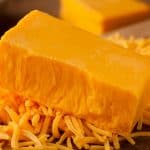Description
Discover this versatile, flavorful, and firm cheese by making it at home and enjoying it with friends and family.
Ingredients
For some 2 pounds of Cheddar cheese you need:
- 2 gallons of milk, cow or goat. It should be non-ultrapasteurized. If you’re using raw milk make sure to decrease its culture by 25-40%.
- ⅛ tablespoon of calcium chloride dissolved in ¼ cup of water, in case you’re using pasteurized milk.
- Mesophilic culture of your choice:
- 1 pack of direct-set MC, or
- ⅛ tablespoon bulk MC;
- Rennet of your choice (dissolve in ½ cup of cold water):
- ¼ tablespoon vegetable rennet;
- ¼ tablespoon double-strength liquid rennet;
- ½ tablespoon liquid animal rennet;
- 2 tablespoons of sea salt;
- Some whey.
Equipment
To properly prepare home-made cheddar cheese you’ll need the following equipment:
- 1 large pot;
- 1 smaller pot – optional;
- 2 pans (one with holes and one without) or a colander;
- 1 cheesecloth;
- Lard or cheese wax;
- 1 long knife – not necessarily sharp;
- Cheese press;
- Thermometer.
Instructions
1. Heat the Milk
Take the large pot and heat the milk to 86°F. If you’re cooking it on the stove, heat the milk slowly and stir it well. To prevent burning and have better control over water temperature you can put a smaller pot inside the big pot filled with hot water.
Use the thermometer to measure the temperature of both the milk and water.
When the milk reaches 85°F, add the culture inside. Sprinkle the powder on the surface to prevent it from caking and leave for two minutes before you start stirring.
Milk needs to be kept at this temperature for 90 minutes, for the culture to start working.
2. Add Rennet
Add ¾ tablespoon of rennet in the matured milk with culture. Leave the milk for 45 minutes for the culture and rennet to work. The milk takes between 15 and 20 minutes to start thickening and you should be able to see this change by pressing it on the surface.
Leave it for the full 45 minutes as prescribed, and don’t heat, cut, or disturb the thickening milk in any way.
When the time is up, the milk should be turned into a hard cuttable curd.
3. Cut the Curd
The next step of the process of making Cheddar cheese is to cut the curds into half-inch pieces with a long knife, gently. The smaller you cut them, the drier the cheese will be, however, keep in mind they’ll shrink during cooking.
When you’re done cutting, leave them for 5 minutes so their surface can harden a bit.
Then, stir the curds slowly and gently for 15 minutes. In case they have cooled, bring the curds back to the 86°F so they become more firm.
4. Cook the Curds
In order to dry the curds, you need to cook them slowly to 100°F. Increase the temperature by 5°F every 5-7 minutes. The total cooking process shouldn’t be longer than 30 minutes.
The next step is to stir the curds for 30-60 minutes until it becomes firm. If the curds remain soft after 1 hour, just keep stirring.
A curd firm enough should be moderately resistant to finger pressure and pretty dry. To check whether it’s good, take a handful of cheese and apply pressure on it. If they separate easily, they’re good, but if they cling together, they need more steering.
Once the curds are dry enough, leave them under some whey for a few minutes and then remove it within 1-2 inches above the mass.
5. Draining and Cheddaring
Take the two pans, the one with holes with the draining cloth, and place it inside the one with no holes. If you’re going with a colander, just place it in a larger pan.
Transfer the curds into the draining pan/colander and make sure they’re fully covered with whey. If you notice any clumps it’s okay to break them by stirring.
After the 15-minute draining process, fold the cloth over and tighten it around the curd to drain the whey well.
That’s where the cheddaring phase begins, however, beware that cheese still hasn’t fully acidified yet.
The cheddaring phase requires warming up the cheese up to 90°F and flipping for the next 2-3 hours, so the whey can develop enough acid (but not too much). After the first hour, cut the curd in half and put it in separate draining cloths.
During this process, the curds will probably change shape from more cubic or round, to more elongated and flattened.
6. Milling and Salting the Curds
At this point, the curd mass should be cut into smaller chunks. Add some salt to it at the rate of 2% to a fresh curd’s weight.
For example, if the curd is 3lbs heavy, 2% is 0.96oz.
Finished cheese will contain around 1,5% of the added salt. If you want to prevent the salt hardening the curd surface, put it in three stages over a 20-minute period.
7. Forming and Pressing
Take the salted curds and pack them into a sanitized cloth and into the mold. Pressing should start very lightly and then slowly increase. You can start with 20lbs and then increase by 10 or 20 every hour. Leave the 50-75lbs weight for 24 hours and then remove the cheese from the press and gently unwrap.
8. Aging
Traditionally, well-pressed Cheddar should be wrapped in cloth which provides excellent support for the cheese surface, but also allows moisture and gas to pass. When applying the cloth you can first soak it in lard and bind the Cheddar cheese inside for 24 hours. When you remove the cloth you’ll be able to easily brush off the mold.
Aging cheese should be kept in a space warmed at 52-56°F and with 80-85% moisture. All you need to do is flip it every week to keep the moisture even. Depending on the moisture and your preferences, leave it for 3-18 months.
When it’s aged as much as you like, remove the cheese from the aging space and serve!
Notes
If you are a beginner cheesemaker, take your time with this Cheddar Cheese recipe. It requires an intermediate cooking-skill level.
- Prep Time: 2 hours
- Cook Time: 2 hours

